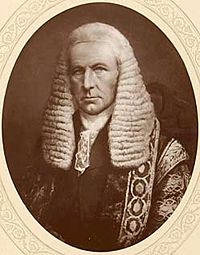- Evelyn Denison, 1st Viscount Ossington
-
The Right Honourable
The Viscount Ossington
PC
Speaker of the House of Commons In office
1857–1872Monarch Victoria Preceded by Sir Charles Shaw-Lefevre Succeeded by Hon. Sir Henry Brand Personal details Born 27 January 1800
Ossington, NottinghamshireDied 7 March 1873 (aged 73) Nationality British Political party Whig, Liberal Spouse(s) Lady Charlotte Bentinck
(d. 1889)Alma mater Christ Church, Oxford John Evelyn Denison, 1st Viscount Ossington PC (27 January 1800 – 7 March 1873) was a British statesman. He served as Speaker of the House of Commons from 1857 to 1872.
Contents
Background and education
Denison was born at Ossington, Nottinghamshire, the eldest son of John Denison (d. 1820), and the brother of George Anthony Denison, a conservative churchman. He was educated at Eton and Christ Church, Oxford.
Political career
 Sir Evelyn Denison, Speaker, in a Vanity Fair cartoon of 1870.
Sir Evelyn Denison, Speaker, in a Vanity Fair cartoon of 1870.A Whig, he became Member of Parliament (MP) for Newcastle-under-Lyme in 1823,[1] being returned for Hastings three years later,[2] and holding for a short time a subordinate position in George Canning's ministry. Defeated in 1830 both at Newcastle-under-Lyme and then at Liverpool, Denison secured a seat as one of the members for Nottinghamshire in 1831. After the Great Reform Act he represented the southern division of Nottinghamshire from 1832 until the general election of 1837.[3]
Denison then represented Malton from 1841 to 1857,[4] and North Nottinghamshire from 1857 to 1872.[3] In April 1857 Denison was chosen Speaker of the House of Commons. He was sworn of the Privy Council at the same time.[5] Re-elected at the beginning of three successive parliaments he retained this position until February 1872, when he resigned and was raised to the peerage as Viscount Ossington, of Ossington in the County of Nottingham.[6] He refused, however, to accept the pension usually given to retiring Speakers. Denison gave a justification—referred to as Speaker Denison's rule — as to why the Speaker casts his or her vote in most cases in favour of, rather than against, a government, where they have the casting vote.
Family
Lord Ossington married Lady Charlotte, daughter of William Bentinck, 4th Duke of Portland, in 1827, but he left no children. He died on 7 March 1873, and his title became extinct. His Ossington Hall estate passed to his nephew William Evelyn Denison, son of his brother Sir William Thomas Denison.[7]
Ossington Street in London was named in his honour. Lady Ossington died in 1889.
References
- ^ leighrayment.com House of Commons: Na H-Eileanan An Iar to Newport
- ^ leighrayment.com House of Commons: Haslemere to Herefordshire
- ^ a b leighrayment.com House of Commons: Northampton North to Nuneaton
- ^ leighrayment.com House of Commons: Macclesfield to Marylebone West
- ^ London Gazette: no. 21998. p. 1616. 8 May 1857.
- ^ London Gazette: no. 23827. p. 550. 13 February 1872.
- ^ "Biography of William Evelyn Denison (1843-1916)". Manuscripts and Special Collections. University of Nottingham. http://www.nottingham.ac.uk/manuscriptsandspecialcollections/collectionsindepth/family/denison/biographies/biographyofwilliamevelyndenison%281843-1916%29.aspx. Retrieved 15 November 2010.
 This article incorporates text from a publication now in the public domain: Chisholm, Hugh, ed (1911). Encyclopædia Britannica (11th ed.). Cambridge University Press.
This article incorporates text from a publication now in the public domain: Chisholm, Hugh, ed (1911). Encyclopædia Britannica (11th ed.). Cambridge University Press.
External links
- Hansard 1803–2005: contributions in Parliament by Evelyn Denison
- Archival material relating to Evelyn Denison, 1st Viscount Ossington listed at the UK National Register of Archives
- Portraits of (John) Evelyn Denison, 1st Viscount Ossington at the National Portrait Gallery, London
- Papers of the Denison family, held at Manuscripts and Special Collections at The University of Nottingham
- Anonymous (1873). Cartoon portraits and biographical sketches of men of the day. Illustrated by Waddy, Frederick. London: Tinsley Brothers. pp. 20–21. http://en.wikisource.org/wiki/Cartoon_portraits_and_biographical_sketches_of_men_of_the_day/Mr._Speaker. Retrieved 2010-12-30.
Parliament of the United Kingdom Preceded by
William Kinnersley
Sir Robert Wilmot, BtMember of Parliament for Newcastle-under-Lyme
1823 – 1826
With: Sir Robert Wilmot, BtSucceeded by
Richardson Borradaile
Sir Robert Wilmot, BtPreceded by
Sir William Curtis, Bt
Sir Charles WetherellMember of Parliament for Hastings
1826 – 1830
With: James Lushington, to 1831;
Joseph Planta, from 1831Succeeded by
Sir Henry Fane
Joseph PlantaPreceded by
Frank Sotheron
John LumleyMember of Parliament for Nottinghamshire
1831 – 1832
With: John LumleyConstituency abolished New constituency Member of Parliament for South Nottinghamshire
with The Earl of Lincoln
1832 – 1837Succeeded by
The Earl of Lincoln
Lancelot RollestonPreceded by
Viscount Milton
John ChildersMember of Parliament for Malton
1841–1857
With: John Childers, to 1846;
Viscount Milton, 1846–1847;
John Childers, 1847–52;
Hon. Charles Wentworth-FitzWilliam, from 1852Succeeded by
James Brown
Hon. Charles Wentworth-FitzWilliamPreceded by
Lord Henry Bentinck
Lord Robert ClintonMember of Parliament for North Nottinghamshire
1857 – 1872
With: Lord Robert Pelham-Clinton, to 1865;
Lord Edward Pelham-Clinton, 1865–1868;
Frederick Chatfield Smith, from 1868Succeeded by
Hon. George Monckton-Arundell
Frederick Chatfield SmithPolitical offices Preceded by
Sir Charles Shaw-LefevreSpeaker of the House of Commons
1857–1872Succeeded by
Hon. Sir Henry BrandPeerage of the United Kingdom New creation Viscount Ossington
1872–1873Extinct Categories:- 1800 births
- 1873 deaths
- People from Nottinghamshire
- Old Etonians
- Alumni of Christ Church, Oxford
- Members of the United Kingdom Parliament for English constituencies
- Speakers of the House of Commons of the United Kingdom
- UK MPs 1820–1826
- UK MPs 1826–1830
- UK MPs 1831–1832
- UK MPs 1832–1835
- UK MPs 1835–1837
- UK MPs 1841–1847
- UK MPs 1847–1852
- UK MPs 1852–1857
- UK MPs 1857–1859
- UK MPs 1859–1865
- UK MPs 1865–1868
- UK MPs 1868–1874
- Whig (British political party) MPs
- Politics of Newcastle-under-Lyme
Wikimedia Foundation. 2010.

